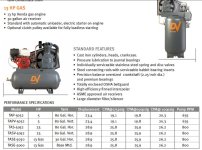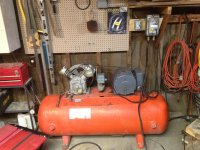If the rubber feet are original equipment for that compressor/tank, probably won't help with sound level but would still help if you want to tilt the tank for better drainage -
If the rubber feet are someone's attempt at quieting, they could be either helping, hindering, or neither.
This gets into the realm of mass-spring-mass calculations - ever seen a sign on a long suspension bridge that said "no dogs allowed"? This isn't because the bridge maintenance crew doesn't wanna clean up your pooch's messes, it's because of RESONANCE. (Another term for mass-spring-mass effect) -
In the case of the bridge/dog, typically a dog will go into a trot when it's going somewhere - it's a very constant series of "little jumps", so to speak. If that particular dog's weight and "frequency of thumps" happens to coincide with a harmonic of the bridge's natural resonance, it works just like pushing your kid on a swing - if you time the pushes right, he'll go higher and higher. In the case of the bridge, there have been cases of dogs destroying a bridge under the wrong circumstances.
In the case of your compressor, the air pump will have a specific resonant frequency based on rpm (which you just changed by changing motor speed slightly, and pulley ratio) - the mass of the entire unit also enters into the resonance of the device - the rubber feet are the "spring", and the earth (considered infinite for calculation purposes usually) is the other "mass" - hence the "mass-spring-mass calculation.
There are two instances when a spring is NOT a spring - these are at either end of its travel. So if the rubber feet are compressed enough (due to being too small or soft or both) then they are no longer "springs", and might as well not even be there.
If those rubber feet are the wrong hardness (called shore value) they will either compress too much, or not enough - they need to be near the middle of their range between uncompressed and flattened to work well. If their travel during "thumps" of the compressor gets too close to either end of their range, you'll get noise transfer to whatever the compressor is sitting on. Once it gets to your floor, part will be deadened by the earth under the slab and part will transfer to walls and ceiling, which will amplify the noise (typically)
Oh man, just realized I drifted into "auto" mode - sorry. Did I mention that I do some acoustical consulting from time to time? :confused2:
Shorter answer - oh yeah, that was the FIRST sentence

...Steve

